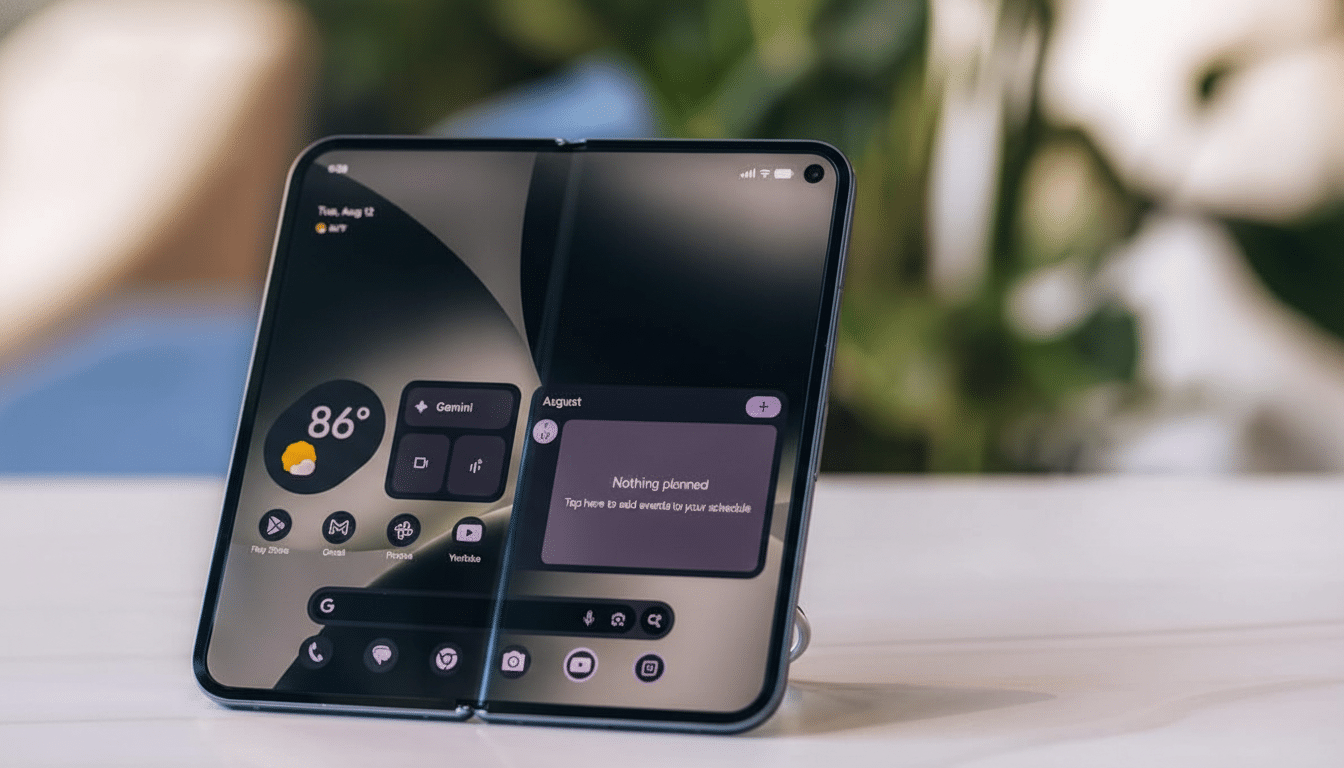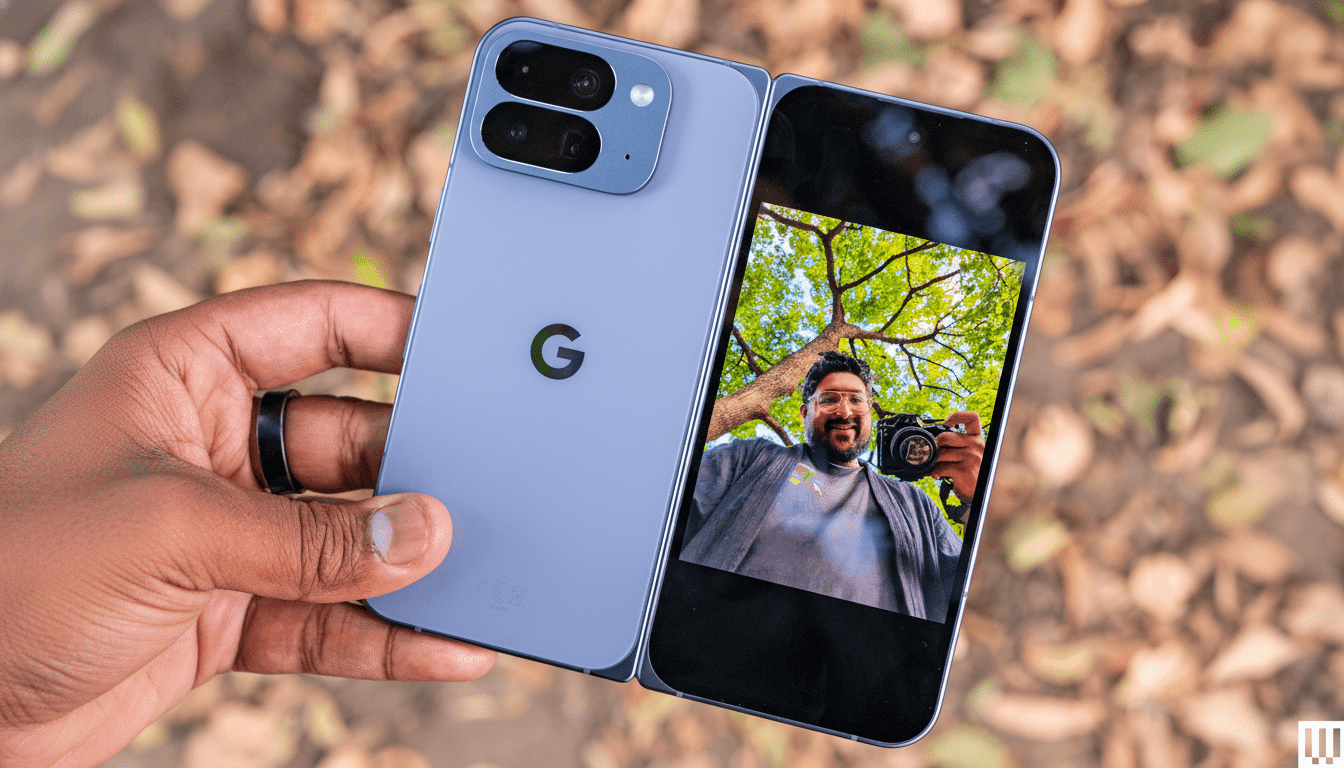There are two heavyweight foldables fighting for pocket space, and neither is shy about its lust for power. Google’s Pixel 10 Pro Fold emphasizes AI-first features and stamina, while Samsung’s Galaxy Z Fold 7 focuses on a slimmer, lighter body with no-nonsense multitasking. If you’re in the market for an upgrade to a book-style foldable, this is the match to keep an eye on.
Design and durability: size, materials, and protection
Samsung’s Z Fold 7 cuts mass and thickness in ways you notice the moment the phablet is in your hands. It’s considerably lighter than the Pixel 10 Pro Fold, and it folds flatter as well, meaning that you can pack it into your pocket or bag without much hassle. Google’s device is chunkier but hits back with an IP68 rating for full dust and water resistance, a first for a book-style foldable at this level.
- Design and durability: size, materials, and protection
- Displays and multimedia: cover refresh and inner OLEDs
- Performance and thermals: chips, RAM, and sustained speed
- Cameras and video: sensors, zoom range, and stabilization
- Battery life and charging: capacity, speeds, and accessories
- Software and AI: Android updates, features, and productivity
- Multitasking and productivity: windows, DeX, and workflows
- Value verdict: pricing, strengths, and best use cases

Materials matter. Google keeps things simple with Corning Gorilla Glass Victus 2, while Samsung goes for a blend of Gorilla Glass Ceramic 2 on its display cover and Victus 2 on the rear. Both hinge systems focus on durability — the average foldable advertises at least 200,000 folds before it wears out — but the practical lightness of Samsung’s material gives it the upper hand when you actually get hands-on time with it.
Displays and multimedia: cover refresh and inner OLEDs
Each phone uses a standard-size cover screen and an 8-inch inner OLED. The Z Fold 7’s outer panel goes from 1Hz to 120Hz — a win for both smoothness and battery when reading static content. Google’s cover screen is 60Hz to 120Hz but can go super bright outdoors.
On the inside, both provide spacious, crisp canvases for multitasking and media. On paper, the Pixel’s inside display is the brighter of the two, and Samsung matches its 1- to 120Hz refresh flexibility. Neither supports a stylus, so note-takers will need to get by with finger input and third-party keyboards. For video streaming and split-view reading, they’re both great; Samsung’s adaptive cover refresh is the quieter winner for glanceable use.
Performance and thermals: chips, RAM, and sustained speed
Google’s Tensor G5 is coupled with 16GB of RAM in the Pixel 10 Pro Fold, which will be optimized for on-device AI and sustained multitasking. Samsung responds with a Snapdragon 8 Elite for Galaxy and 12GB of RAM, focusing on peak performance and gaming responsiveness. Assume the Snapdragon will score higher in raw benchmarks and GPU-intensive titles, while Tensor chugs along Google’s AI pipelines without a hiccup.
Thermals are a (literally) quiet story in foldables because of cramped spaces. The Z Fold 7’s thinner body remains remarkably high on sustained performance under extended gaming or video export, while the Pixel will prioritize steadiness as your AI features continually spin up.
Cameras and video: sensors, zoom range, and stabilization
A 48MP main camera, 10.8MP 5x telephoto, and 10.5MP ultra-wide are what you’ll find on the Google phone. Samsung fires back with 200MP primary, 10MP 3x telephoto, and 12MP ultra-wide. In real-world shooting, the Pixel’s 5x optical “reach” is the cleaner mid-to-far zoom, while Samsung’s higher-resolution main sensor exhibits sharp daytime detail and assured focus.
Video is one of the differentiators: The Z Fold 7 records up to 8K30, and with stabilization that’s reliably strong for this class. The Pixel maxes out at 4K60 but comes with Google’s color science and noise treatment. Each phone has a selfie camera on the cover and another on the inner display, which makes hands-free vlogging and video calls straightforward when docked.
Battery life and charging: capacity, speeds, and accessories
On battery capacity, things swing in Google’s favor with 5,015mAh versus Samsung’s 4,400mAh. The Pixel gets 30W of wired charging and the Fold, 25W; both include 15W wireless. The Pixel lasts longer on independent review looped endurance trials, which is no surprise when taking into account its bigger pack and more cautious cover refresh.

Google’s Pixelsnap magnetic charging system is the X factor of accessories. It’s something akin to the tried-and-true magnetic ecosystem you’ll find in the world of iOS, delivering snap-on wallets, stands, and chargers natively on Android. If you’re interested in life on battery packs and desk docks, that ecosystem lift will count.
Software and AI: Android updates, features, and productivity
Both devices ship with Android 16 and offer seven years of OS and security updates, which aligns with the new high-water mark for longevity. The Pixel embraces first-party AI: There’s Magic Cue, which shows you information before you even ask, and Live Voice Translate that offers better-than-you-would-expect voice recreation for two-way calls.
Samsung folds Google’s A.I. into One UI, and then layers on its productivity tools. The result is less about any one feature and more a sense of breadth: strong window control, robust clipboard handling, and smart suggestions that actually cater to large-screen workflows. Both Counterpoint Research and IDC have said that software optimization is the No. 1 lever in foldable satisfaction; Samsung’s tuning tells.
Multitasking and productivity: windows, DeX, and workflows
This is where the Z Fold 7 breaks away. It can also show more apps at once, surf across windows with less head-scratching lag, and launch DeX to your monitor for a desktop-style view. For on-the-go or power users, that turnkey desktop mode is a true laptop-light stand-in for email, Docs, and browser research.
The Pixel does not lag behind: split-screen is fast; there’s great app continuity with Google’s first-party apps scaling beautifully. But if you live in the UI equivalent of three panes—chat, calendar, and docs all onscreen—the Samsung experience is still the best.
Value verdict: pricing, strengths, and best use cases
It’s expensive either way you slice it, but the Pixel does undercut Samsung at similar storage options and packs 16GB of RAM from day one. If you care about longer battery life, even stronger mid-range optical zoom, magnet-attached charging accessories, and Google’s latest AI tricks, the Pixel 10 Pro Fold is the smarter purchase.
If you want the lightest pocket feel, the most polished multitasking, higher video ceilings, and desktop mode on demand, the Galaxy Z Fold 7 justifies its premium.
That answer will change, of course; with foldables surging for adoption — both IDC and DSCC have tracked double-digit growth continuing apace — the best choice would be the appropriate one for how you actually work. For productivity power users, pick Samsung; for AI-focused daily drivers, pick Google.

